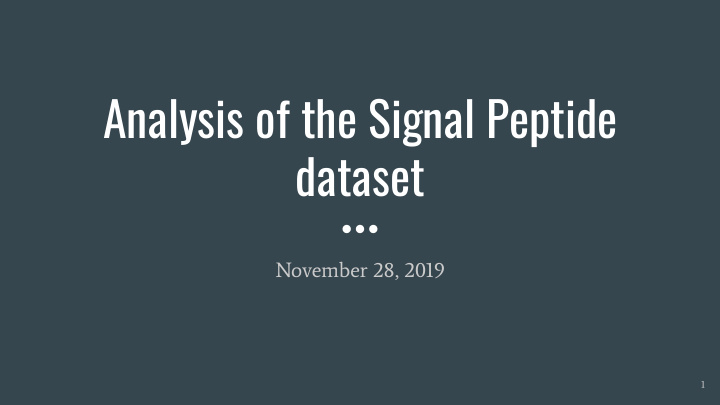



Analysis of the Signal Peptide dataset November 28, 2019 1
Signal Peptide - A short peptide (typically 15-30 residues long), destined towards the secretory pathway - Cleaved during translocation across membrane existing in all 3 kingdoms of life 2
Our dataset ● FASTA format is a text-based format for representing either nucleotide sequences or peptide sequences, in which base pairs or amino acids are represented using single-letter codes. A sequence in FASTA format begins with a single-line description, followed by lines of sequence data. The description line is distinguished from the sequence data by a greater-than (">") symbol in the first column. It is recommended that all lines of text be shorter than 80 characters in length. 3
Our dataset ● The FASTA file contains for each protein (in order): ● Header (e.g. ">Q8TF40|EUKARYA|NO_SP|0") ● Protein sequence (first 70 residues only) ● Residue annotation 4
Our dataset The header contains information about: ● The protein ID (e.g. "Q8TF40") ● The kingdom of life the organism (that contains the protein) belongs to (e.g. "EUKARYA") ● The type of signal peptide the protein contains (e.g. "NO_SP") ● The data set split the protein belongs to (e.g. "0") 5
Our dataset ● 20,758 proteins ● 4 types of signal peptides ● 6 residue types ● 20% sequence similarity 6
Our dataset ● 5 splits for cross-validation with similar residue distribution ● Cross-validation is a resampling procedure used to evaluate machine learning models on a limited data sample. The procedure has a single parameter called k that refers to the number of groups that a given data sample is to be split into. As such, the procedure is often called k-fold cross-validation. 7
Class distributions Strong dataset imbalance: most proteins ● don’t contain Signal Peptides SP Signal Peptide LIPO Lipoprotein Signal Peptide TAT Tat Signal Peptide NO_SP No Signal Peptide 8
Residue annotations 91.25% S Sec/SPI signal peptide T Tat/SPI signal peptide L Sec/SPII signal peptide I Cytoplasm M Transmembrane 8.75% O Extracellular 9
Prediction Baseline 10
Dealing with class imbalance Undersampling (majority classes) ● Oversampling (minority classes) ● Class weights ● SMOTE (synthetic samples) ● 11
ELMo Embeddings ELMo Embeddings: ● Embedded Language Models Used in Natural Language Processing ● In our case, embeddings represent the context of each residue ● Either 64 dim or 1024 dim per residue ● 12
Learning from high-dimensional data Reduce the dimensions ● t-SNE ● ● Techniques for dimensionality reduction and clustering that preserve the proportionality of the objects -> Visualization of high dimensionality datasets 13
PCA vs t-SNE 14
Results of t-SNE for the 64 dim embeddings 15
Results of t-SNE for the 64 dim embeddings for L signal peptides 16
Results of t-SNE for the 64 dim embeddings for S signal peptides 17
Results of t-SNE for the 64 dim embeddings for T signal peptides 18
Notes ● Results are based on the perplexity = 30 ● Not a lot of information ● 1024 dimensional embeddings can be more helpful 19
References ● https://zhanglab.ccmb.med.umich.edu/FASTA/ ● https://machinelearningmastery.com/k-fold-cross-validation/ ● https://towardsdatascience.com/visualising-high-dimensional -datasets-using-pca-and-t-sne-in-python-8ef87e7915b 20
Thank you very much! 21
Recommend
More recommend